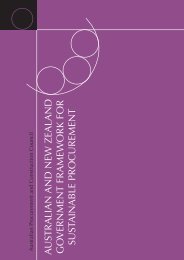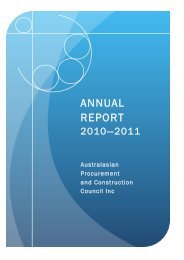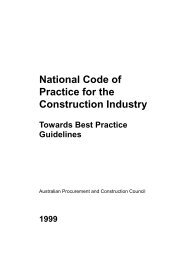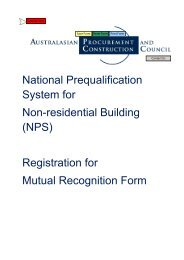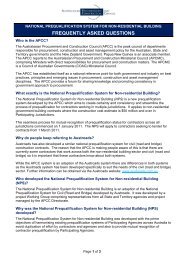Improving Security of Payment Building and Construction Industry
Improving Security of Payment Building and Construction Industry
Improving Security of Payment Building and Construction Industry
- No tags were found...
You also want an ePaper? Increase the reach of your titles
YUMPU automatically turns print PDFs into web optimized ePapers that Google loves.
9. Mutual Fund Insurance Page 109National Public Works Council Inc<strong>Improving</strong> <strong>Security</strong> <strong>of</strong> <strong>Payment</strong> in the <strong>Building</strong> <strong>and</strong> <strong>Construction</strong> <strong>Industry</strong>The HGF comprised a pool <strong>of</strong> funds which were sourced from the following contributions:• Builder registrationsUnder the relevant Regulations each builder was required to be registered <strong>and</strong> pay anannual fee, which varied depending on the balance <strong>of</strong> funds within the HGF. In 1996the annual registration fee was $180.• Job registrationPursuant to the Regulations, every job undertaken by a builder had to be registered<strong>and</strong> a registration fee was to accompany the registration. The registration fee wasdependant upon the nature <strong>of</strong> the job with fees ranging from $135 to $280 for jobs inthe private sector <strong>and</strong> up to $450 for jobs in the public sector. This cost was in turnpassed onto the Principal via the building contract.The HGF was simply a guarantee to the building owner <strong>and</strong> his successors in title "<strong>of</strong> theperformance <strong>of</strong> the builder's obligations under the Domestic <strong>Building</strong> Works Contract". Theliability <strong>of</strong> the fund was to make good loss or damage suffered by the building owner or hissuccessor in title on account <strong>of</strong>:• The failure <strong>of</strong> the builder to fulfil its obligations under the contract; or• In any case, a defect caused by bad workmanship during the guarantee period. Theguarantee period was seven (7) years.Basically, there was a limit to the liability <strong>of</strong> the HGF, which was capped at $40,000 <strong>and</strong> aclaim could be made on the fund only where the value <strong>of</strong> the work performed was greaterthan $3,000.The scheme worked with difficulty <strong>and</strong> was ab<strong>and</strong>oned recently as part <strong>of</strong> the reform <strong>of</strong> thesystem governing the Victorian <strong>Building</strong> <strong>and</strong> <strong>Construction</strong> <strong>Industry</strong>.The reform was initiated with the proclamation <strong>of</strong> the <strong>Building</strong> Act in 1993. This Legislationrestructured the method for obtaining an approval <strong>of</strong> building permits by permitting issue byprivate building surveyors. It also created compulsory pr<strong>of</strong>essional indemnity <strong>and</strong> publicliability insurance for building practitioners.Significantly, the insurance was underwritten by a limited number <strong>of</strong> some four (4) privateInsurers. These Insurers were not interested in considering involvement in the Scheme untilit was compulsory for the whole industry <strong>and</strong> backed by legislation.In May 1996 the Domestic <strong>Building</strong> Contracts <strong>and</strong> Tribunal Act was introduced as anextension <strong>of</strong> the <strong>Building</strong> Act to cover the domestic building environment simultaneouslyreplacing the Housing Guarantee Fund.The Housing Guarantee Fund applied to all domestic work commenced prior to 1 May 1996.From that date, the Domestic <strong>Building</strong> Contracts <strong>and</strong> Tribunal Act applied.



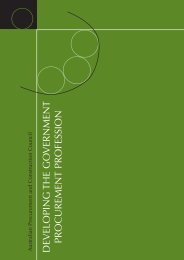
![NATIONAL COST ADJUSTMENT PROVISION EDITION 2 [NCAP2]](https://img.yumpu.com/48266135/1/184x260/national-cost-adjustment-provision-edition-2-ncap2.jpg?quality=85)

